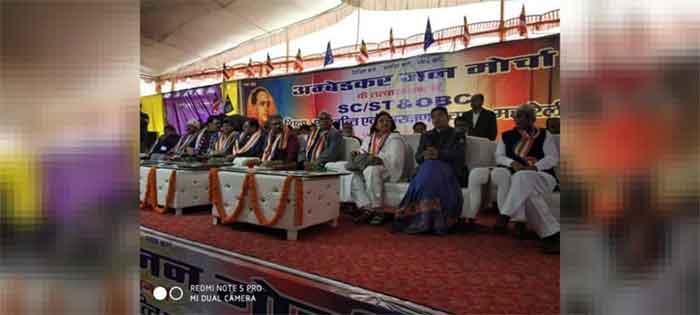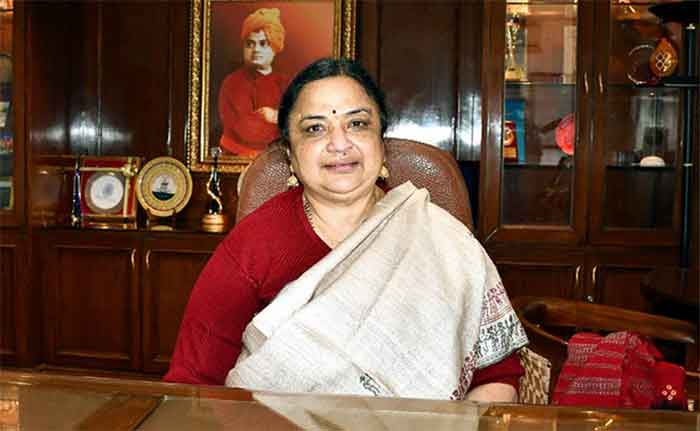
Following the brutal police killing of Georg Floyd, an African-American Citizen of US, an unprecedented wave of movement for black rights is sweeping all over the world. The powerful message of Black Lives Matter has been conveyed through mass rallies, demonstrations, and more forcefully by setting fire to the Minneapolis Police Department building and, in some places by toppling the statues symbolizing racist traditions. Revived by this international momentum for black rights, the long-standing demand to remove the statue of Manu from the precincts of Rajasthan High Court is strengthening in India.
How come the statue of Manu is in a high court in the first place? A group of Dwija Lawyers seems to be the culprit. From its very erection in 1989 by Rajasthan Judicial Officers Association, this ten-feet statue of Manu has been courting condemnations and protests from anti-caste activists across India. Most recently in 2018, two rebellious Dalit women – Kantabai Ahire and Sheela Pawar — from Maharashtra have painted Manu with black paint to protests against his casteist and misogynistic philosophy.
Statues symbolize history, while they are not history themselves. They represent and memorialize a stand on history. What Manu represents especially with reference to law and Justice? In the long history of the subcontinent, the infamous Manu could be credited for having systematically and eloquently propagated the ideology of Brahminical Supremacy and graded hierarchy. In fact, Manu was the original reservationist, which escapes the understanding of ‘meritorious’ Dwija castes who violently protest against affirmative action for the lower castes. Manu cunningly claimed 100% reservation for Brahmin caste in terms of attaining literary, learning vedic, teaching, performing rituals like Shradda and sacrifices and being a guru. These intellectual and religious non-productive activities including that of begging (receiving gifts) were delineated as the domain proper for Brahmins. Their claim to literacy and Vedic knowledge, throughout the ages, have offered the Brahmin caste an unmatched social supremacy as well as virtual monopoly in high-paying employment that is close to the circles of power.
Manu is fundamentally against the egalitarian edifice of modern constitutions. The Article 14 of the Constitution of India confers on all citizens ‘equality before the law or the equal protection of the laws’. Manu is the archenemy of treating all humans fair and equal. Ambedkar has unequivocally demonstrated his opinion on Manu’s laws when he burnt a copy of Manusmriti during the Mahad Satyagraha of 1927.
A preliminary reading of Manu demonstrates that he is the most bigoted caste supremacist, who takes utmost pain to segregate and discriminate fellow humans in their privileges and duties. Manu spares no domain of life in the service of entrenching the graded Varna hierarchy in which the Brahmins reigns supreme and other dwijas above Shudras and Dalits. Even in naming, a Brahman’s should be of auspicious and happiness while Sudras name should have names showing their ordinariness and servitude. [v.2.31, The Laws of Manu]. In the current context, Manu declares that almost eighty percent of India’s population as born from the foot. And these shudras and outcastes have a separate assigned duty which is ‘to serve meekly other three Varnas’ [v.1.91, The Laws of Manu]. All Dalits and Shudras including Gujjars of Rajastan, Jats of Uttar Pradesh and Haryana, Patels of Gujarat, Marathas of Maharastra and Yadavs of all states, apart from the listed Other Backward Classes (OBC) and are victims of Manusmriti till today.
Under the veil of political democracy, Indian society is still influenced and shaped by the dynamics of caste hierarchy and monopolies. The appearance and continued support for Manu statue is also should be understood in this context. For instance, Manu was hailed as the ‘cosmic law-giver’ in one of the popular academic textbooks dealing with Indian Political Thought in which Ambedk ar’s thought wasn’t political enough.
Manu does not belong to the past; he is still haunting the present by getting inscribed in the fundamental framework of the so-called democratic country. Manu’s vicious injunctions are upheld thorough out the ages despite many upsets and reversals that the Brahminism has faced. Still, the castes that are involved in productive bodily labour are disproportionately Dalits, Adivasis and Shudras, while the twice-born castes prosper with their caste privilege. Still the Brahmins command invincible power, while some retaining their priestly power, some have cashed their social power for the sake of more future-proof secular roles. Take Judiciary for instance 47% of chief justices between 1950 to 2000 were Brahmins. The Banias, who are part of Manu’s twice-born, control major chunk of monopoly capital of India. The Kshatriyas treat Shudras and Dalits as worthy of humiliation at will. Yogi Adityanath’s shuddhikaran of the Chief Minister’s residence after Akhilesh Yadav vacated it was part of the Manudharma treatment.
As much as the British colonialism threatened the old Brahminical hegemonies, it also played a crucial role in its rejuvenation and re-incarnation in the modern times. Translation and publication of past Brahminical texts by the Orientalists lead to the revival of the Brahminical traditions. Further, British officers like William Jones were instrumental in promulgating the extremely regressive Dharmashastra as a legal-regulative text 1772 to 1864. This brought extreme distress to the wider populace of Shudras and Dalits since these measures brought back the tyranny of Manudharmawith renewed vigour.
Manu could actually a befitting mascot for the Judiciary where the five rape accused, in Bhanwari Devi case involving a Dalit woman, was acquitted by the blatantly Brahminical reasoning that it’s improbable for those upper caste men to rape a woman from lower caste, for the fear of being polluted. So, it is clear that, for the Judiciary, Manu does not represent the ugly past of caste inegalitarianism as the slave masters of Euro-America represented racism. Rather his regressive dictums are revisited in the bodies of the Dalits, Adivasis, Shudras and women through the brahminical machinations of the criminal justice system, both in its commissions and omissions.
Dalits, Shudras, Adivasis and women of this country have rational and historical reasons to bring down the statue of Manu. While the Dalits are time and again able to demonstrate their collective power against the transgressions against their rights as witnessed in the instances of Una (2016), Saharanpur (2017) and Bhima Koregaon (2018), Barath Bandh (2018) the Shudra castes were largely unable to realize and fight against the caste boundedness in which they are laboring and serving the interests of Dwija elites. The intermediate-castes across India are involved more in asserting their own caste pride than realizing the need for a unified voice when their interested are jeopardized by the subterranean modern reincarnation of Varna hierarchy. Unless the Shudras and leave their feeling of caste inferiority of Dwijas and caste superiority over Dalits, it would be very difficult to bring down the statue of Manu, let alone his vicious ideology.
Karthik Raja Karuppusamy, Senior Research Fellow, Centre for Political Studies, Jawaharlal Nehru University.
SIGN UP FOR COUNTERCURRENTS DAILY NEWSLETTER














































